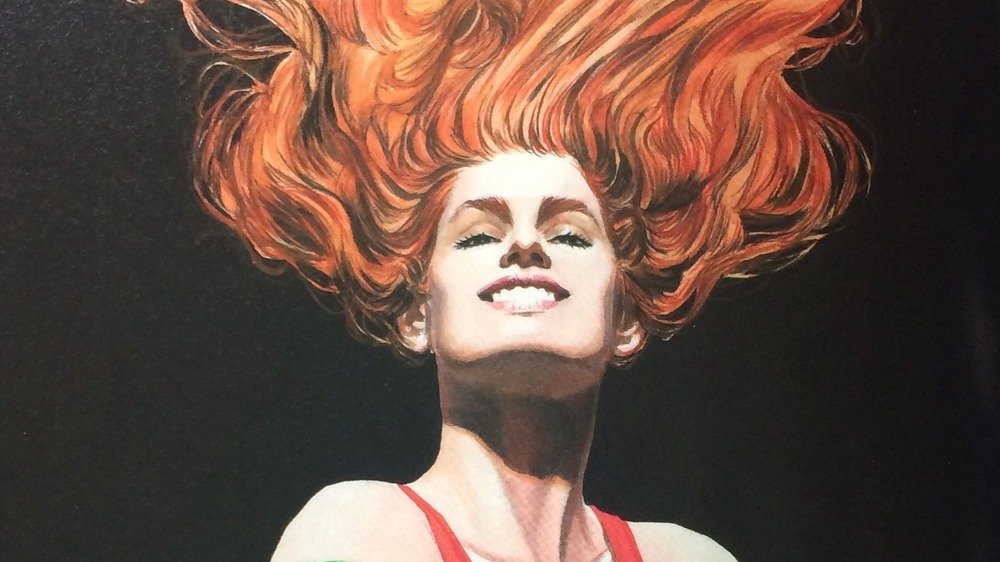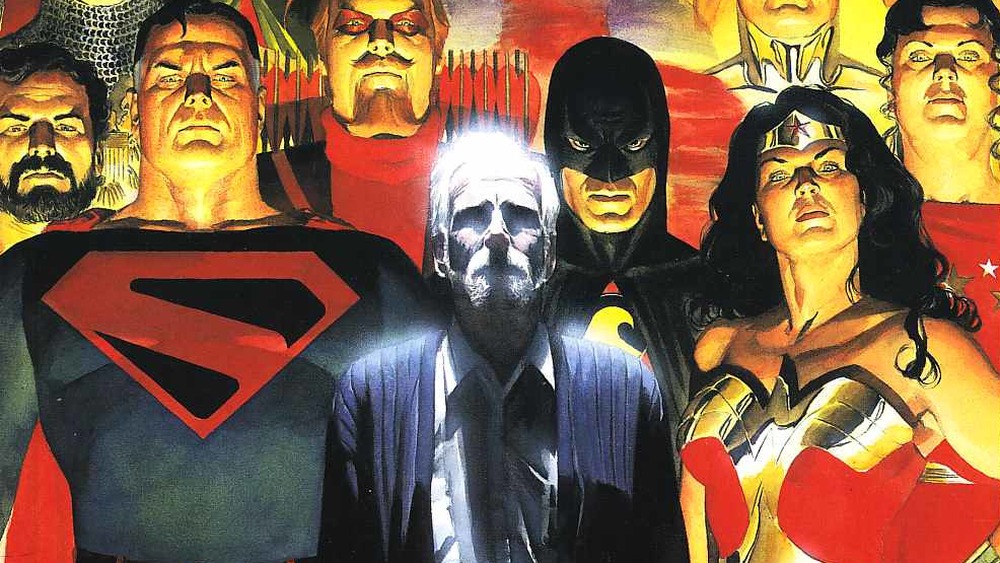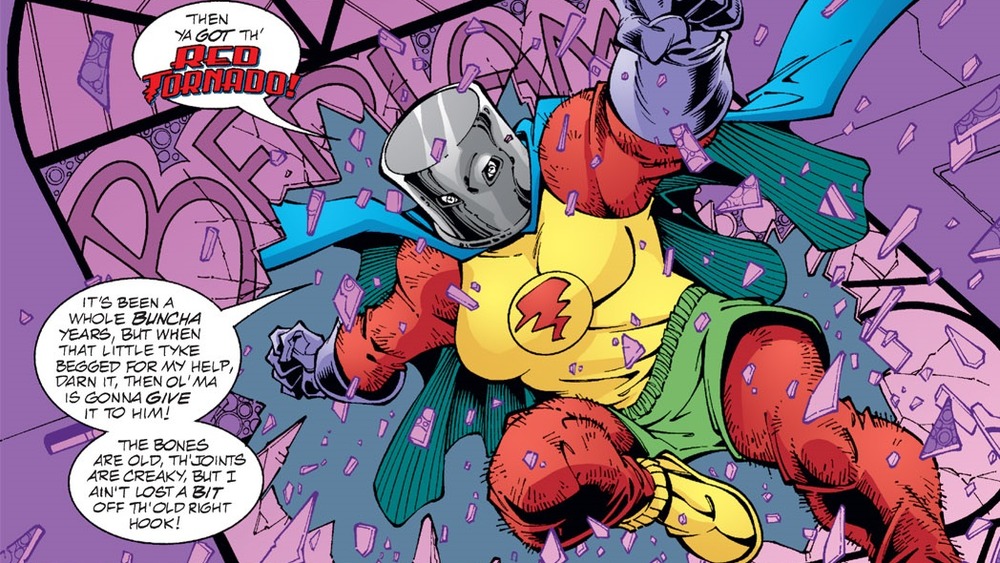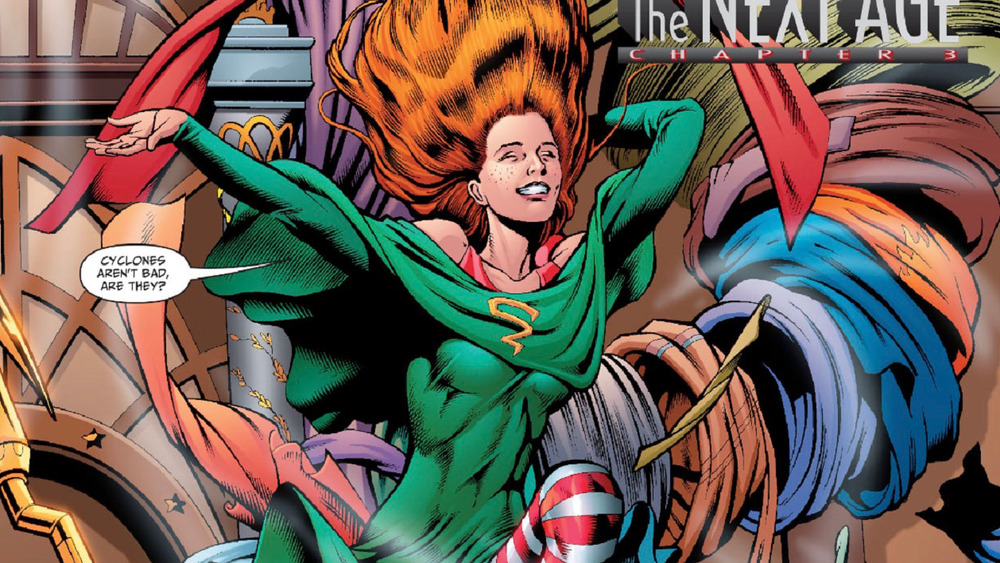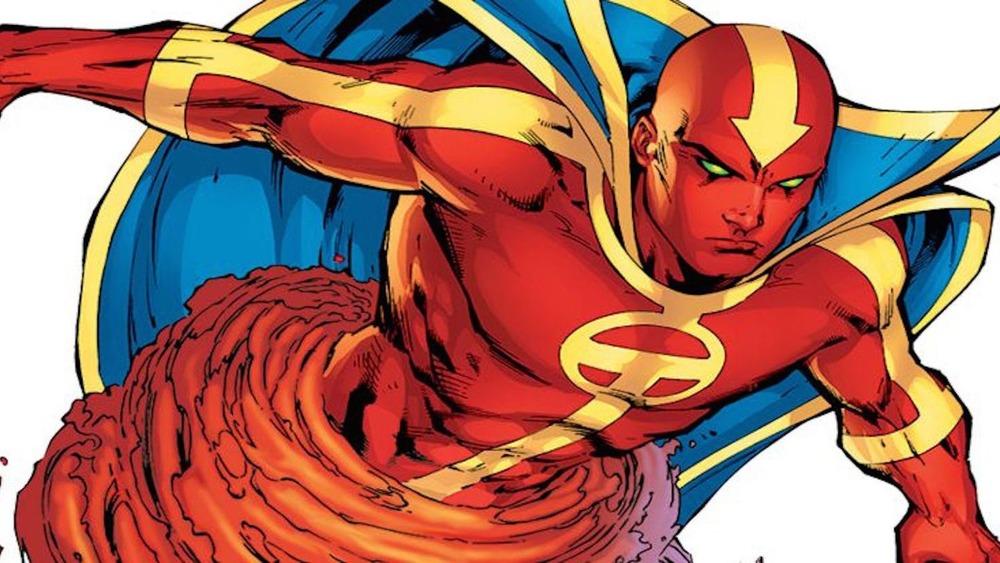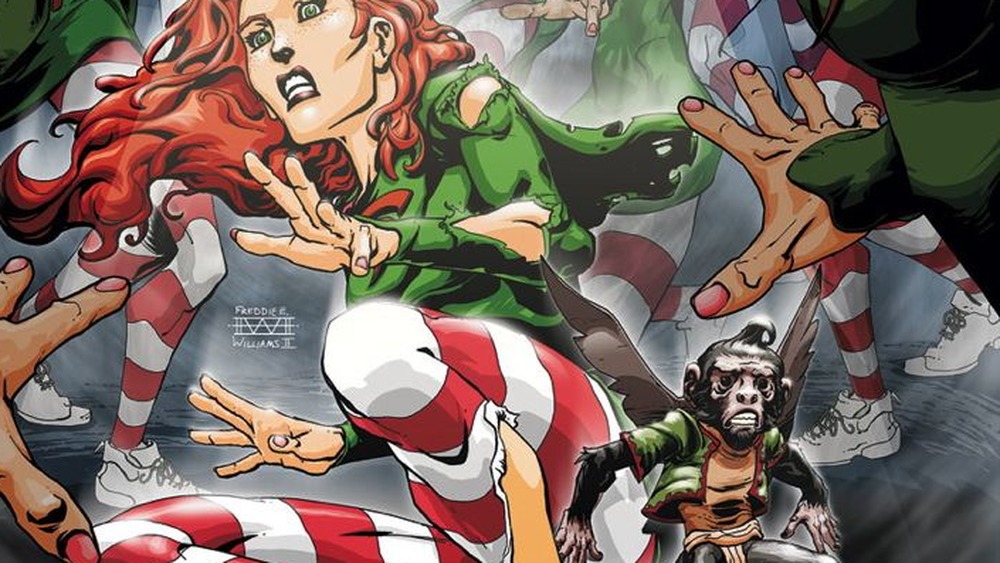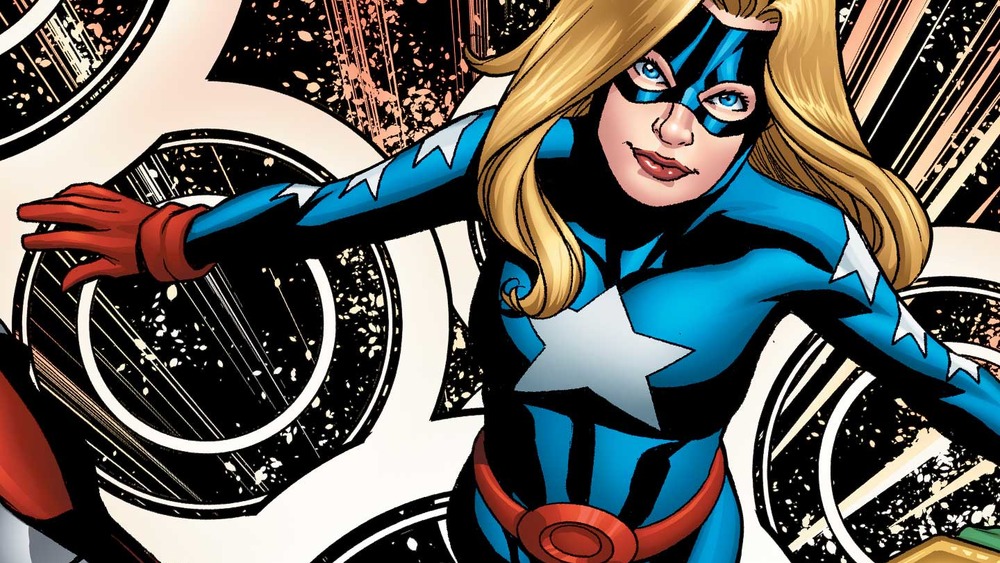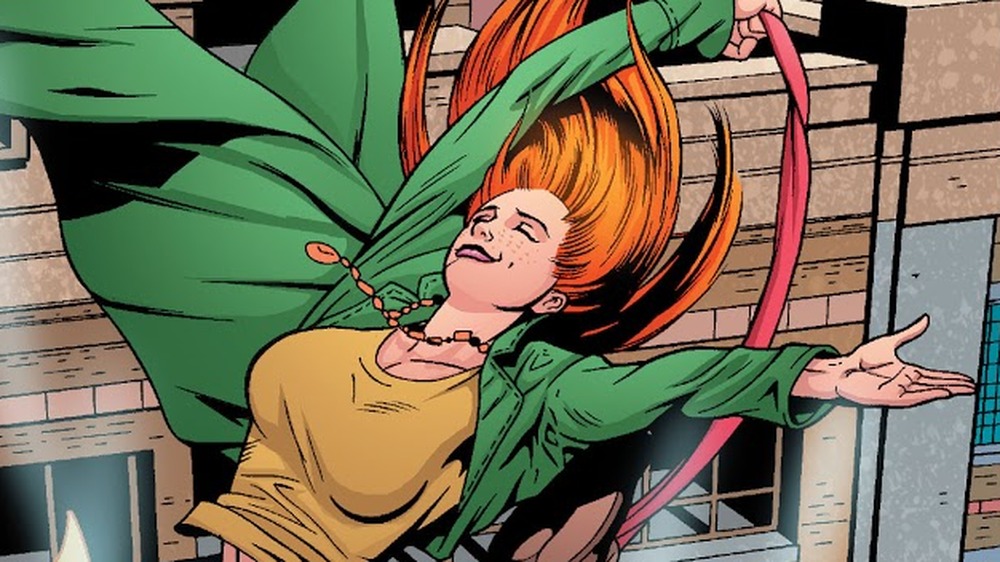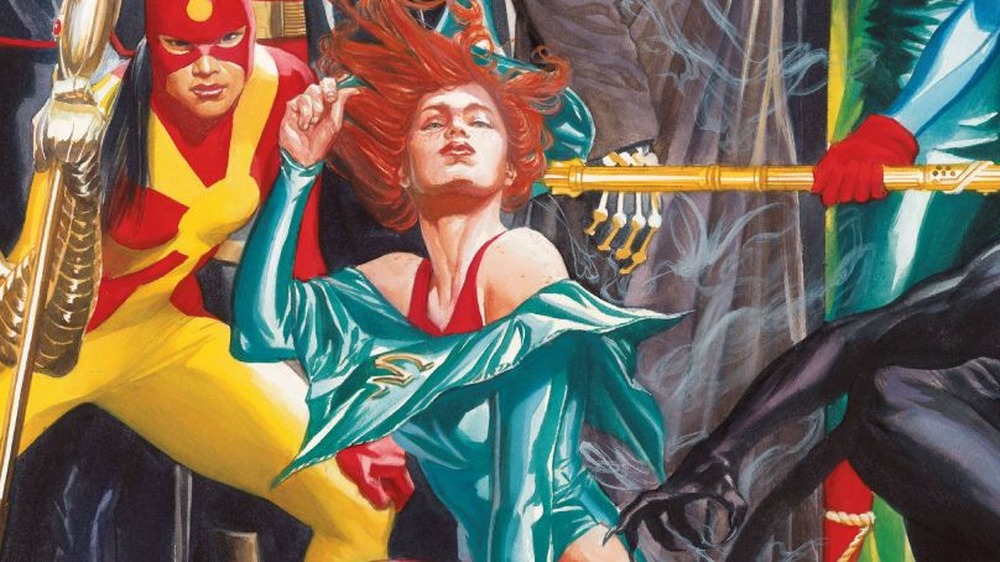The Untold Truth Of DC Comics' Cyclone
We live in an era in which any superhero, even the most niche, has a chance of gaining a live-action movie or TV appearance. The cape-and-cowl set are one of those rarest Hollywood commodities: A sure thing that consistently turns a profit. If you're not a fan of the genre, perhaps living in a reality where Marvel and DC dominate popular culture is positively nightmarish. But for longtime fans of the Big Two's respective universes, it's a dream come true.
The latest relatively obscure crimefighter to ascend from paper to celluloid comes direct from the late '00s Justice Society Of America series. Black Adam features Quintessa Swindell — noted for their performances on Euphoria and Trinkets — as the JSA's spunky teen sidekick, Cyclone. Swindell's character is listed as "Maxine Hunkell/Cyclone," which is noteworthy, as Cyclone's last name is traditionally spelled with a single "l." We don't know if that's a deliberate change on the part of the filmmakers, or a mistake from IMDB. Either way, since this article is mostly about comics, we'll stick with "Hunkel" going forward.
In the comics, Cyclone's powers are pretty self-explanatory. Picture Storm from the X-Men, except the only aspect of weather she controls is the wind. That's how Cyclone rolls — or, well, whooshes. This is her story, from her superheroic grandma to her future on the silver screen.
She's a product of an all-time classic Justice League story
Watchmen and Dark Knight Returns might have started the grim 'n gritty deconstructed superhero boom of the 1980s, but Kingdom Come, by Mark Waid and Alex Ross, poses one of its most essential question: "Who deconstructs the deconstructions?" This 1996 miniseries documents the return of Superman and the rest of the Justice League (except Batman) to a bleak future where metahumans have grown careless, cynical, and needlessly brutal. Superman comes out of retirement to take a stand against this wanton cruelty.
Amid all the chaos of the apocalyptic battle for the future of sentient life on Earth, readers can easily miss how much story Waid and Ross manage to squeeze into the background of Kingdom Come's frequently-crowded panels. For instance, a romantic subplot involving Bruce Wayne's son and Dick Grayson and Starfire's daughter plays out without any dialogue, or any real connection to the primary story. This is also the context in which Waid and Ross premiere a new female Red Tornado, who eventually provides the basis for Cyclone.
Proto-Cyclone fights alongside Justice Leaguers in Kingdom Come #2, as well as during the bonkers issue #4 showdown. We never see her speak, and she never demonstrates any individuality beyond her costume and power set. She seemingly exists only to fight other flamboyantly-attired characters, so really, she exists to help Kingdom Come satirize the notion of superheroes as interchangeable intellectual properties.
Her grandma used to fight crime with a stew pot on her head
We bet some of you reading this think Wonder Woman was the first-ever female superhero. Well, let it be known history places at least one female annihilator of evil approximately a year ahead of Princess Diana of Themyscira, and she is worth any comic fan's time. Created by Sheldon Mayer, Abigail Mathilda "Ma" Hunkel premiered her alter-ego Red Tornado in 1940's All-American Comics #20. Wonder Woman, in contrast, didn't make her first appearance until All-Star Comics #8 in 1941. While Ma Hunkel came first, Wonder Woman does have an edge over her in that she never disguises herself as a man, nor does she wear a mask fashioned from a stew pot with drilled-in eyeholes. Though honestly, making kitchenware work as a crime-fighting costume element might be a point in Ma Hunkel's favor — to say nothing of the fact that she becomes a crime-fighter as a middle-aged working mom.
We learn of her granddaughter Maxine Hunkel's ancestry during her first appearance in 2007's Justice Society of America #1. Mr. Terrific and Power Girl approach the young woman soon-to-be-known as Cyclone as she casually flies around Harvard Yard in broad daylight, refreshingly unconcerned with keeping her metahuman abilities a secret. Conveniently for readers in need of exposition, Terrific and Power Girl tell the Ivy leaguer that they know she's Ma Hunkel's granddaughter, and invite her to join the relaunched JSA.
She's a lighthearted character in a grimdark universe
Like so many classic superhero stories before it (think Days of Future Past), Kingdom Come explores dystopic alternate timelines. As fans know, a dark possible future isn't dark unless it includes stuff like the Joker slaughtering the entire staff of The Daily Planet and other extreme unpleasantries of that nature. Glancing at the decidedly sunnier Alex Ross covers for the 2007 JSA series, you might expect a little less brutality from the title. You'd be tragically mistaken. The inaugural story arc, "The Next Age," by Geoff Johns and Dale Eaglesham, doesn't skimp on the wholesale gruesome massacre of civilians at the hands of superpowered Nazis.
However, it's also readers' first introduction to Maxine Hunkel, a loquacious college kid and superhero fangirl. And although Cyclone doesn't beat up as many Nazis as Hawkman, or battle the immortal madman Vandal Savage to a virtual draw like Wildcat, she's the closest thing to a relatable human person in "The Next Age." Uniquely, she has a life at Harvard that she'd presumably have even without her wind-manipulation powers. And unlike many other characters, her entire family isn't ripped apart by Nazis or assassins. In her first arc, Cyclone's introduction plays the essential role of keeping the rest of the plot from bumming everyone out.
Her powers come from the maniac who created the second Red Tornado
We don't mean to insult any dedicated Cyclone fans who happen to be reading this, but it seems fair to suggest that among the DC superhero hierarchy, she's something of a C-lister. Although she's popular enough to have her own action figure, she's made zero appearances in media outside of comics, save her role in Black Adam. Technically, that makes her a lot less famous than the likes of Condiment King and Kite Man.
When it came time to tell her origin story, Geoff Johns and Fernando Pasarin opted to get right to the point. In JSA #5 – an issue that's primarily concerned with an unrelated attack by Doctor Destiny on Arkham Asylum — Cyclone encounters Red Tornado during a fact-finding trip to the Fortress of Solitude. During their conversation, we learn that several years previously, the mad scientist T.O. Morrow intended to lure Red Tornado into a trap of some sort by abducting the original Red Tornado's granddaughter. When Hunkel was six years old, Morrow kidnapped her and injected her with the nanobytes that brought about her wind-manipulation abilities.
Why did Morrow think giving his hostage superpowers was a good idea? Well, like we said, he's a mad scientist, not a clear-thinking, logical scientist.
She has a pet monkey
Frankie the Monkey is Cyclone's beloved companion, carrying on the proud tradition of superhero pets like Krypto, Ace the Bat-Hound, Lucky the Pizza Dog, and Spider-Man the Cat.
Named after Wizard of Oz author L. Frank Baum, Frankie the monkey emerges during the JSA's conflict with the absurd and terrible entity known as Gog. In Justice Society of America #17, Cyclone explains that Frankie started following her around in the seemingly arbitrarily manner some animals have towards specific humans. His monkey-sized vest and wings were fashioned by Cyclone's teammate Jakeem Thunder, thereby adding to Cyclone's Wizard of Oz costume motif — which is also a Wicked motif, as Cyclone is a musical theater nerd and a devoted fan of that legendary Broadway smash. To Cyclone's mild shock and relief, Frankie appears to enjoy wearing the outfit, which means no animals were harmed or even made uncomfortable in the making of this comic book.
She's BFFs with Stargirl
Stargirl has joined the ranks of DC characters at the helm of their own TV shows. But back in 2007, only Superman wielded enough raw strength and notoriety to headline a network series, and the idea of the JSA amounting to more than a one-off gag in any live-action movie or series sounded pretty far-fetched. As fans know, that's hardly the case these days.
An early version of the Justice League that has reemerged in DC media intermittently throughout the decades, the JSA shows up on the big screen for the first time in Black Adam. Alongside Cyclone, frequent JSA affiliates Hawkman and Atom Smasher are also present, played by Aldis Hodge and Noah Centineo, respectively.
While it's established that Hunkel has admired Stargirl since high school, their relationship dynamic isn't really what you'd expect from a fan and the object of their fandom. They first hit it off in Justice Society of America #2, right after the bleeding carcass of Mr. America falls through the ceiling at JSA headquarters and lands directly on the meeting table. Whitmore comforts Hunkel, who's on her literal first day of superhero business and is not emotionally prepared for the sight of the recently murdered. A bit later in Justice Society of America #3, Whitmore helps Hunkel put together a costume, and sort through codename ideas. They dismiss Red Hurricane, Zephyr, and Cyclone Kid, before landing on Cyclone.
She hasn't actually appeared in a comic in a while
Cyclone vanished from DC Comics after the 2016 line-wide relaunch Rebirth, and only popped up again recently in 2019's Doomsday Clock. Meanwhile, there hasn't been an official JSA ongoing comic series since the Flash decided he simply had to mess with the space-time continuum in the 2011 Flashpoint crossover, leading to the New 52 reboot. DC also hasn't announced any plans for a new JSA book in the immediate future. So why is a big-budget film starring one of the world's biggest movie stars putting the spotlight on a team of superheroes who aren't popular enough to earn their own comic book?
We can guess, but ultimately, we can't know for sure. Global media conglomerates work in mysterious ways, after all. But at least there's a logical reason for including Cyclone, specifically, in Black Adam's version of the JSA. An all-male team would look pretty weird, and the other female heroes closely associated with the JSA, Stargirl and Power Girl, are both closely linked with other ongoing live-action projects. Power Girl, AKA Kara Zor-L, isn't the same character audiences recognize as Kara Zor-El from Supergirl, but good luck explaining that to someone who's never heard of an alternate timeline. Thus, Cyclone gets her spotlight, much to the delight of her fans.
We can expect a departure from the source material ... or can we?
What does Cyclone's inclusion in the DCEU tell us about the universe's future? Not much that's concrete, but there is a whole lot fans can infer. Black Adam includes virtual unknowns like Cyclone and Atom Smasher, while The Suicide Squad features the quintessentially anonymous likes of the Polka-Dot Man and Thinker (plus King Shark, but there's nothing anonymous about him, of course). The DCEU isn't putting all its eggs in the proverbial Batman, Superman, and Wonder Woman baskets any longer. Much in the way the Marvel Cinematic Universe evolved beyond being totally beholden to its source material, DC is working to appeal to moviegoers who don't bring a pre-existing fondness for the relevant iconography to their movie-viewing experience.
The folks behind Black Adam understand 95 percent of its audience has never read a JSA comic before in their lives, didn't grow up watching Black Adam cartoons ('cos there aren't any), and won't recognize Cyclone or any other Black Adam characters from other movies ('cos they haven't been in any other movies). As in the case with The Suicide Squad, this is an instance of filmmakers trying something new — which portends well for the entire DCEU franchise.
